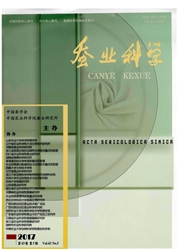

 中文摘要:
中文摘要:
将产下后48h的家蚕滞育卵和即时浸酸卵进行低温(5℃)冷藏处理30d以上,滞育卵孵化率显著上升,而即时浸酸卵孵化率显著下降。为了探讨低温处理对滞育卵和即时浸酸卵的孵化产生不同影响的分子机制,测定了冷藏期间2种卵中的H2O2含量、过氧化氢酶(CAT)基因mRNA转录水平和CAT活性变化。结果表明:2种卵在冷藏期间随着卵中的H2O2含量显著增加,CAT基因mRNA转录水平也上调;虽然冷藏后的10~70d,2种卵中的H2O2含量、CAT基因mRNA转录水平及CAT活性都显著上升,但滞育卵的H2O2含量仍显著高于即时浸酸卵,而CAT基因mRNA转录水平和CAT活性则显著低于即时浸酸卵。即时浸酸卵在冷藏过程中H2O2含量显著增加,可能造成了对胚胎的氧化伤害,从而降低其孵化率。然而,滞育卵在冷藏过程中的CAT基因mRNA转录水平及CAT活性相对较低,H2O2相对较高,胚胎却未受到氧化伤害,推测低温处理可能诱导了滞育卵中其它抗氧化反应。
 英文摘要:
英文摘要:
The 48 h-old diapause eggs and the hydrochloric acid (HCl)-treated eggs of the silkworm,Bombyx mori, were chilled at 5 ℃ for over 30 d.It was found that hatchability of the diapause eggs increased markedly and that of the HCl-treated eggs decreased markedly.To clarify molecular mechanism underlying distinct effects of chilling on the hatch-ability of diapause eggs and the HCl-treated diapause eggs,hydrogen peroxide (H2O2) content,catalase mRNA transcriptional level and catalase activity in these two types of eggs were determined during chilling at 5 ℃.The results showed that,during chilling,as H2O2 content increased remarkably,mRNA transcriptional level of CAT gene was also up-regulated in both types of eggs.After chilling for 10~70 d,although H2O2 content,catalase mRNA transcriptional level and catalase activity all increased remarkably,H2O2 content in the diapause eggs was still significantly higher than that in the HCl-treated eggs,while catalase mRNA transcriptional level and catalase activity were lower than the HCl-treated eggs.That H2O2 content in HCl-treated eggs increased remarkably during chilling were likely to cause oxidation injury to the embryos and thus lead to the decrease of hatchability.Nevertheless,catalase mRNA transcriptional level and catalase activity in the diapause eggs during chilling were relatively lower and H2O2 content was relatively higher, but the embryos were not injured by oxidation,suggesting that chilling might have led to the induction of other anti-oxidation reactions in the diapause eggs.
 同期刊论文项目
同期刊论文项目
 同项目期刊论文
同项目期刊论文
 Antioxidant activity of the derivatives of polysaccharide extracted from a Chinese medical herb (Ram
Antioxidant activity of the derivatives of polysaccharide extracted from a Chinese medical herb (Ram 期刊信息
期刊信息
